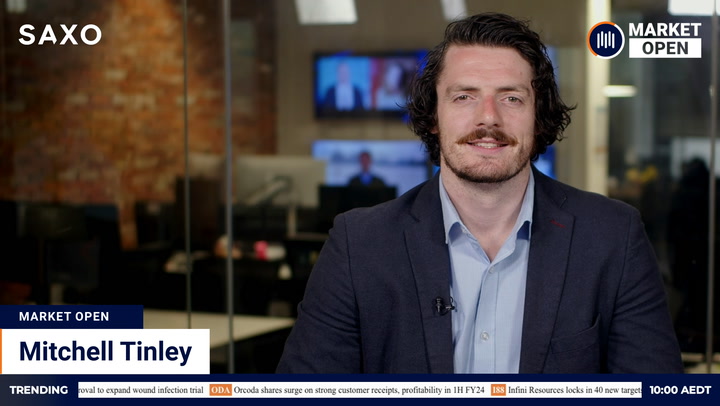The share market has a fifth straight advance in reach for the first time this year after the US Federal Reserve reassured jittery investors the central bank will be “careful” raising rates.
US stocks rallied after Fed Chair Jerome Powell indicated the Ukraine war had not significantly altered the central bank’s plans. Wall Street’s main indices all put on at least 1.6 per cent.
The S&P/ASX 200 was set to open 69 points or 0.97 per cent ahead, according to futures action. The Australian benchmark has recovered steadily since last Thursday’s low, supported by strengthening commodity prices.
Overnight, aluminium set a new record and nickel touched a decade high. US oil hit a level last seen in 2011. Iron ore inched ahead. Gold dropped back.
Wall Street
Investors put aside their defensive playbooks and waded back into risk assets after Powell’s testimony before a congressional committee clarified the outlook for rates and the economy. The Fed Chair acknowledged the Ukraine war, but indicated the central bank remained set on raising its target range this month.
A broad rebound lifted 29 of 30 companies on the Dow Jones Industrial Average. The blue-chip average bounced 596 points or 1.79 per cent.
The S&P 500 reversed Tuesday’s loss with a gain of 80 points or 1.86 per cent. All 11 sectors advanced. The Nasdaq Composite added 220 points or 1.62 per cent.
Powell wiped away any uncertainty about the central bank’s intentions for its meeting in two weeks. The Fed Chair said it would be appropriate to raise the target range and he supported an increase of 25 basis points.
“The bottom line is we will proceed, but we will proceed carefully, as we learn more about the implications of the Ukraine war on the economy,” he said.
Treasury yields rebounded, boosting bank stocks. The yield on ten-year US treasuries climbed more than 16 basis points.
“You’re bringing some levels of certainty to the market. It also kind of helps the market assess the seriousness of the war and what the real counter risks may have been,” Eric Schiffer, chief executive officer of private equity firm Patriarch Organization, told Reuters.
“And if the Fed felt that those risks were stronger, there would be a question of whether they would raise at all.”
Energy stocks added to gains as oil benchmarks settled above US$110 a barrel. The US benchmark, West Texas Intermediate, climbed US$7.19 or 7 per cent to US$110.60. Front-month contracts logged their highest finish since May 2011.
The international benchmark, Brent crude, settled US$7.96 or 7.6 per cent ahead at US$112.93 a barrel, the strongest close since June 2014.
The rally came after the OPEC+ oil cartel stuck to plans to increase production by 400,000 barrels a day next month. The group of major producers had been under pressure to ramp out output to replace a shortfall caused by the ostracization of Russia. Bloomberg reported there were no bids for a cargo of deeply-discounted Russian crude this week due to shipping and finance challenges.
Australian outlook
A week-long recovery looks set to continue after the Fed helped put the Ukraine war in perspective. While the humanitarian cost is immeasurable, the economic hit to most economies looks likely to be modest at this point.
The S&P/ASX 200 hit its “war low” on Thursday and has since bounced 126 points in four days. Five-session winning runs are infrequent, but not impossible. The most recent was the “Santa rally” across Christmas.
“The ASX 200 was one of the few major Asian indices to scrape a gain yesterday, thanks to a strong GDP report,” City Index senior market analyst Matt Simpson said. “It’s back above 7100 and reaffirmed support at 7042.80 (which was previously resistance).
“Futures point to a higher open and Wall Street is up so, going into today’s session, we have a bullish bias on the day. And a daily close above 7160 puts the bulls firmly back in control.”
Overnight, the dollar climbed above 73 US cents for the first time since mid-January, boosted by expectations the economy will benefit from commodity price gains. The Aussie was lately up 0.56 per cent at 73.01 US cents.
The tone of the night was “risk on”. The energy sector continued to outperform in the US, rising 2.22 per cent to a four-year high. The financial sector bounced 2.55 per cent after Powell reassured investors rates will rise, creating margin opportunities for lenders.
The risk-sensitive tech sector gained 2.19 per cent, materials 2.24 per cent and industrials 2.19 per cent. Traditional defensives also advanced, but gains were smaller.
A busy day on the domestic economic calendar includes construction data at 8.30 am AEDT, and building approval and trade figures at 11.30 am. China releases services-sector data at 12.45 pm.
Commodities
The spread of Russian sanctions and the threat of reduced supply lifted aluminium to a new record. Three-month aluminium hit US$3,597 a tonne on the London Metal Exchange before trimming its rise to 0.23 per cent at US$3,486 a tonne.
Prices have risen 37 per cent in less than three months. Stocks at LME warehouses have more than halved.
“We’re now seeing the second-round effects from the sanctions,” analyst Daniel Briesemann at Commerzbank said. “Logistics issues will get even worse and supply problems are on the cards right now.”
A surge in nickel to its highest since May 2011 faded to a loss of 0.51 per cent. Three-month prices were lately at US$25,220 after trading as high as US$25,925.
Copper eased 0.14 per cent, zinc 0.71 per cent and lead 0.06 per cent. Tin finished unchanged.
Gold declined for the first time in three sessions, losing its grip on a 13-month high. Metal for April delivery settled US$21.50 or 1.1 per cent lower at US$1,922.30 an ounce. The NYSE Arca Gold Bugs Index dipped 0.21 per cent.
Iron ore edged higher as traders bet on a demand boost for Chinese steel from the loss of Russian and Ukrainian supply. Chinese steel futures traded at a two-week high. The spot price for ore landed in China increased 55 US cents or 0.4 per cent to US$145 a tonne.
BHP‘s US-traded depositary receipts surged 4.91 per cent. The miner’s UK listing gained 5.07 per cent. Rio Tinto put on 4.4 per cent in the US and 3.53 per cent in the UK.





